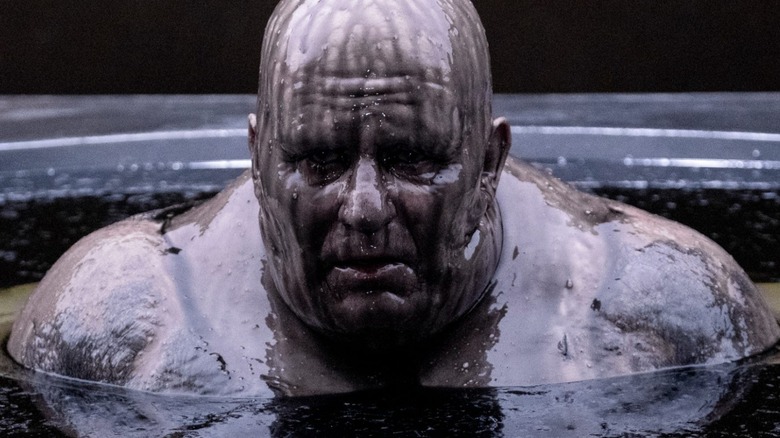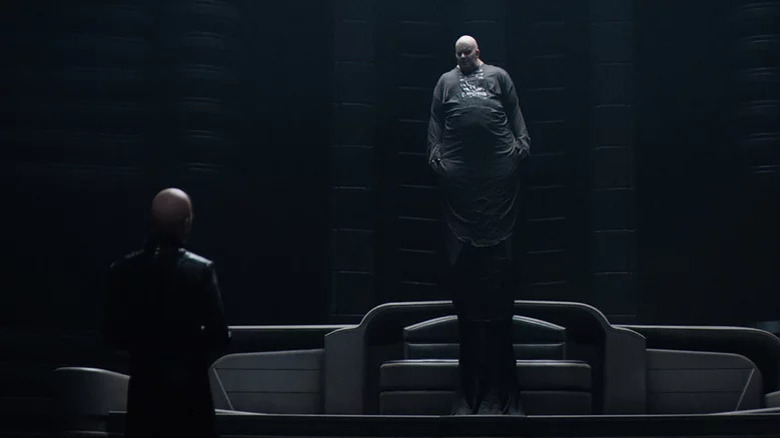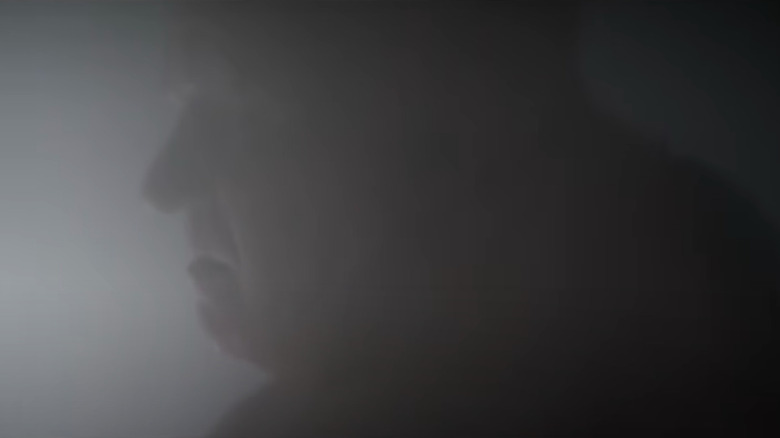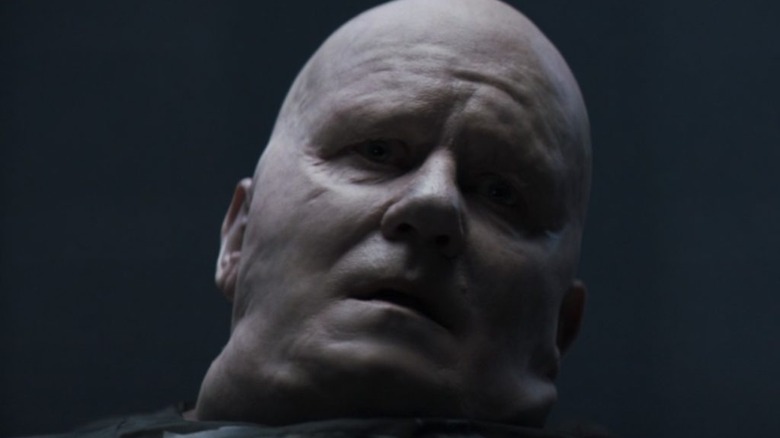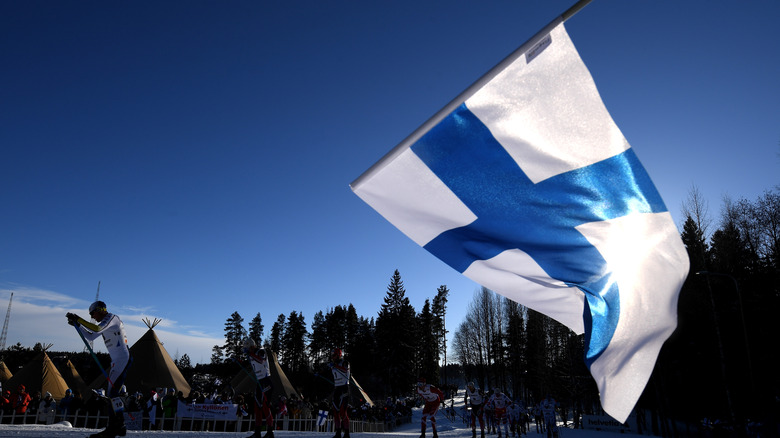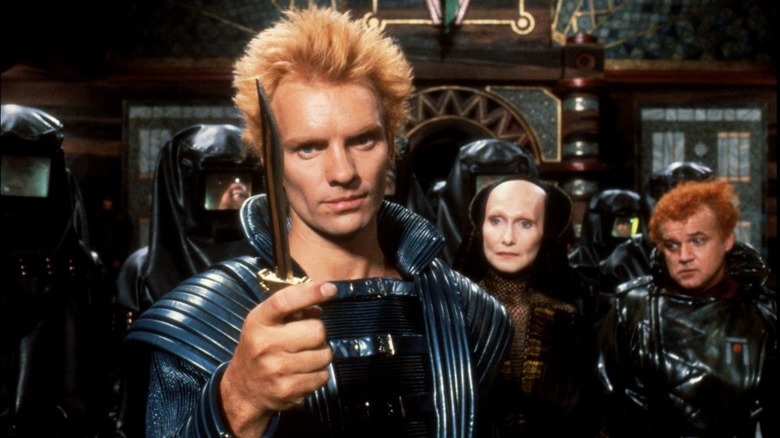Dune's Big Bad Guy Vladimir Harkonnen Explained
Contains spoilers for "Dune"
Imagine that the supreme ruler of the known universe calls you one day, and tells you to take control of the most important planet in existence. Such an event kickstarts the plot of Denis Villeneuve's "Dune," in which young Paul Atreides (Timothée Chalamet) and his father, Duke Leto (Oscar Isaac), have to haul their House Atreides on planet Arrakis, a sandy hellhole infested by giant sandworms ... and littered with the highly vital, miraculous substance known as melange.
If you've seen the movie or are otherwise acquainted with the "Dune" universe, you know that the whole thing is actually a ruse to get rid of the uncomfortably popular House Atreides with the help of the planet's "previous" rulers, House Harkonnen. This brings us to the main villain of Villeneuve's "Dune," Baron Vladimir Harkonnen. Portrayed with oily, gruff menace by Stellan Skarsgård ("Chernobyl," the "Pirates of the Caribbean" franchise, Marvel Cinematic Universe), the obese lord has clearly graduated from the university of sci-fi villains with honors, and isn't shy about putting his finely-honed skills in intimidation, treachery, and last-minute escapes to good use.
But who, exactly, is this gross, powerful man with a penchant for hovering several feet above the ground? How did the movie bring him to life? Here's "Dune's" villain Vladimir Harkonnen explained.
He used to look very different back in the day
Much like Darth Vader looked like Hayden Christensen in his younger days, Baron Vladimir Harkonnen — who, like the rest of Frank Herbert's "Dune" characters, predates the "Star Wars" villain by over a decade — wasn't always an unappealing mound of malice and rolls of fat. In fact, he used to be quite the looker.
In his younger days, Vladimir was closer to a classic fantasy bad guy, with a well-trained frame, "red-gold" hair, and the requisite, villainous widow's peak. By the time "Dune" takes place, years of debauchery have turned the Baron into the kind of man you see in the movie: So massive that he relies on lifting devices known as suspensors to move around.
There's also an "Expanded Dune" universe take of the Baron's unsavory appearance, which involves a condition he contracted as a punishment for certain particularly disgusting actions. Still, it's probably better to wait until we get a sequel or two before delving too deep into extended universe stuff, right?
The movie version of the characters is quite different from the original
Frank Herbert's first "Dune" novel came out in 1965, and when he crafted a bad guy for the book, he didn't mess around. As a result, the Baron a ruthless sadist in pretty much every aspect. In fact, even the corpulent, manipulative monster in Denis Villeneuve's "Dune" is a pretty heavily revamped version of the irredeemable and somewhat problematic print version of the character (per the Los Angeles Times).
Villeneuve recognized that certain aspects of the book's Baron wouldn't work for modern sensibilities, which is why he gave the character a pretty heavy redesign. "I think the book is more relevant than ever but some of the elements have aged a bit, and I felt that the Baron was sometimes a bit like a mustache-twisting caricature," the director said. "In the book, he is very talkative but in the film I wanted him to be a man of few words. I wanted the Baron to be frightening, to be a threat, to be a very intelligent being, not a fool or a caricature."
Stellan Skarsgard had to go through a difficult make-up process
Stellan Skarsgård is a wonderful actor, but even he required some assistance to transform into a hovering, 600-pound despot. As the Los Angeles Times reports, Denis Villeneuve wanted to turn him into a huge, yet physically frightening presence. "I was trying to bring him closer to the spirit of a gorilla than a fat baby," the director said. "I wanted to get away from a feeling of decadence and more toward a feeling of power."
According to USA Today, this required the 70-year-old Skarsgård to wear an 88-pound prosthetic suit with a hidden cooling system for the role, and the make-up process was nothing short of arduous. In fact, turning Skarsgård into Baron Harkonnen took 6.5 hours, and freeing him from the layers of prosthetics and make-up at the end of the day took a further two. This CGI-free approach demanded a lot from Skarsgård, but allowed for a realistic and terrifying performance. That being said, the actor has submitted a joking request to the director, regarding the potential sequel. "I said, 'Please put Harkonnen in the sequel just for a scene or two," Skarsgård said. "I don't want him to be around too much."
The peculiar origins of Baron Harkonnen's name
"Harkonnen" seems like a pretty good made-up name for a sci-fi villain, but according to Dune Wiki, there's actually a pretty solid and surprisingly grounded etymology behind it. The series takes place in humanity's faraway future, and the name has evolved from the Finnish surname "Härkönen." Per Brian Herbert's book "The Dreamer of Dune: The Biography of Frank Herbert," the Harkonnen-Finland connection is indeed correct, and the "Dune" author found the harsh-sounding name in a phone book.
The idea that Baron Harkonnen's house has its origins in this small Nordic country is a fascinating one. Today, you might know Finland as one of the happiest countries in the world with a unique relationship to metal music. However, fast forward far enough into the future, and these peaceful headbangers might well be the biggest, most depraved tyrants around ... at least, in "Dune's" world.
The Baron's most trusted ally is still unseen in the movie
The 2021 "Dune" has already given you Skarsgård's Vladimir Harkonnen, and his ruthless nephew, the equally waxy-looking but far more physically formidable Glossu Rabban (Dave Bautista). However — spoilers if you've only seen the Villeneuve movie – House Harkonnen's most charismatic monster is still lurking in the shadows. This would be Feyd-Rautha Harkonnen, the Baron's younger nephew, whom he favors over Rabban ... even though Feyd tries to poison him on occasion.
Casual fans might mostly remember Feyd from Sting's turn as the character in the David Lynch version of "Dune." Threatening as he is, he also memorably wears a futuristic, winged codpiece-slash-speedo, which might somewhat undermine the terror. However, don't think for a second that the character is a joke. Feyd is a wicked, smart, and charismatic person, who's also one of the absolute best fighters in the known universe. Essentially, he's a dark mirror image of Paul Atreides, in that they come from a fairly similar background, but Feyd has been fully assimilated into the ambitious, sadistic culture of House Harkonnen.
Young Feyd is conspicuously absent from Villeneuve's "Dune," but might just get to make his grand entrance in the potential sequel. In many ways, he's the final ace in Baron Harkonnen's sleeve, and their stories are yet to intertwine in an important way.
